Advanced Tracking Methods for Commanders: Human Intelligence or Artificial Intelligence?
Rokna Political Desk: The integration of modern technologies such as surveillance cameras, communication systems, and satellite imagery with civil registry and governmental databases has created highly advanced methods for tracking and accurately identifying individuals.

Brigadier General Gholamreza Jalali, head of Iran’s Passive Defense Organization, stated that the tracking of individuals is the result of combining multiple sources and methods, including closed-circuit cameras, mobile and wired communications (voice and data), satellite images, and other sensors.
He added that the publication of civil registry and governmental data—such as national identification numbers, vehicle license plates, addresses, and company information—plays a pivotal role in connecting data points and accelerating the identification of specific locations.
Even in cases where individuals do not use smartphones, the combination of physical evidence (such as movement patterns and surveillance footage) and registered data can help reconstruct a person’s location and routes of travel.
According to Jalali, the final outcome is generally the product of merging advanced technologies—including artificial intelligence and data analytics—with human operations and intelligence networks. In this process, the human element accounts for approximately 20 to 30 percent of the overall effort.
Send Comments